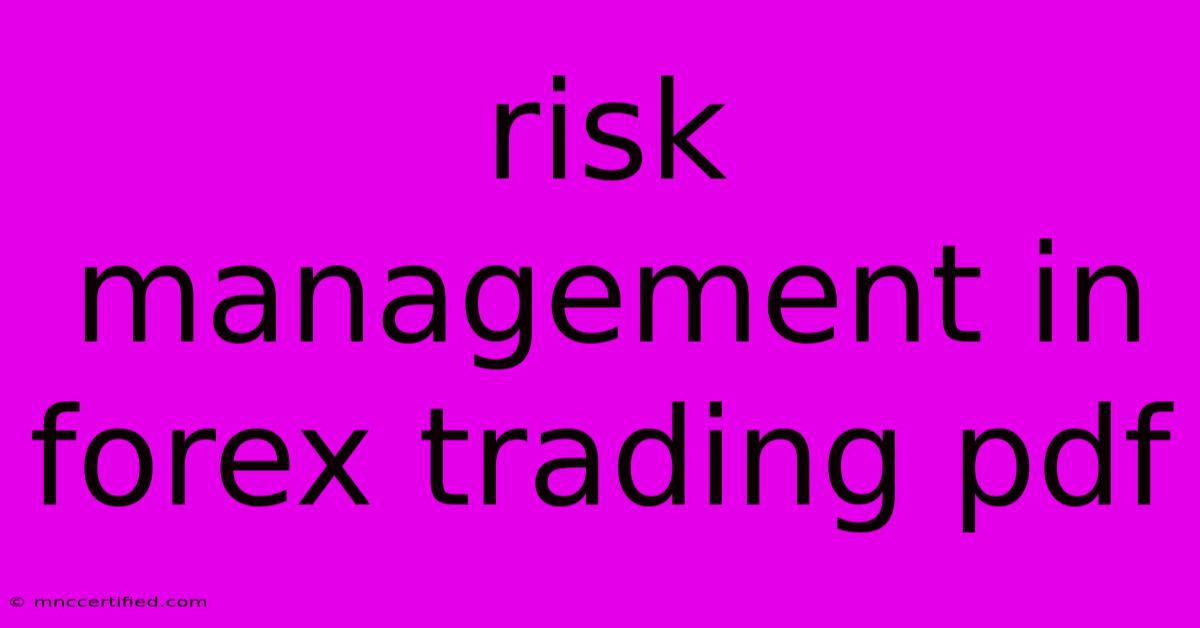Risk Management In Forex Trading Pdf

Table of Contents
Mastering Risk Management in Forex Trading: A Comprehensive Guide (PDF Downloadable)
The foreign exchange market, or Forex, is a global marketplace where currencies are traded. It's a dynamic and potentially lucrative environment, but also one that comes with inherent risks. Effective risk management is paramount for any Forex trader, regardless of experience level. This guide will equip you with the knowledge and tools to navigate the complexities of Forex trading while safeguarding your capital.
Download your free PDF copy of this comprehensive guide on risk management in Forex trading. This downloadable resource provides a detailed overview of key risk management principles, strategies, and practical tips to help you minimize potential losses and maximize your chances of success.
Why is Risk Management Crucial in Forex Trading?
Forex trading involves significant leverage, meaning that you can control a larger position in the market with a smaller initial investment. While leverage can amplify profits, it also amplifies losses.
Here's why risk management is essential in Forex trading:
- Protecting Your Capital: The primary goal of risk management is to preserve your trading capital. By setting limits on your losses, you prevent catastrophic events that could wipe out your entire investment.
- Promoting Discipline: A well-defined risk management plan fosters discipline and prevents impulsive decisions driven by emotions. It helps you stick to your trading strategy, even during volatile market conditions.
- Optimizing Trading Performance: By managing risk effectively, you can focus on profitable trading opportunities without the fear of excessive losses. This allows you to optimize your trading performance over the long term.
Essential Risk Management Strategies for Forex Traders
1. Stop-Loss Orders:
Stop-loss orders are essential for limiting potential losses. They automatically close your trading position when the market reaches a predetermined price level. This helps you exit a trade at a specific loss threshold, preventing further losses as the market moves against your position.
2. Position Sizing:
Position sizing is the process of determining how much capital to allocate to each trade. This is crucial for risk management as it directly influences your potential profit and loss. A common rule of thumb is to risk no more than 1-2% of your trading capital on a single trade.
3. Leverage Management:
Leverage can amplify both profits and losses. It's crucial to understand and manage leverage effectively. Avoid using excessive leverage, as it increases your risk exposure and can lead to substantial losses.
4. Diversification:
Diversifying your trading portfolio by trading different currency pairs and asset classes can help mitigate risk. This reduces the impact of losses from any single trade on your overall portfolio performance.
5. Money Management:
Effective money management involves setting realistic goals, managing your bankroll effectively, and avoiding overtrading. It's about striking a balance between risk and reward, ensuring that your trading strategy aligns with your financial goals.
Common Risk Management Mistakes to Avoid
- Ignoring Stop-Loss Orders: Failing to use stop-loss orders or setting them too wide can result in significant losses.
- Overleveraging: Using excessive leverage magnifies your risk and can lead to substantial losses.
- Emotional Trading: Letting emotions like fear, greed, or hope influence your trading decisions can lead to poor risk management practices.
- Chasing Losses: Attempting to recover losses by increasing your position size or taking more risks can escalate losses further.
- Lack of a Trading Plan: Trading without a clear strategy and risk management plan increases the likelihood of impulsive decisions and losses.
Building a Robust Risk Management Plan for Forex Trading
- Define Your Risk Tolerance: Assess your comfort level with risk and determine how much capital you are willing to lose on any single trade.
- Set Trading Goals: Establish clear and realistic trading goals based on your risk tolerance and financial objectives.
- Choose Your Trading Strategy: Develop a well-defined trading strategy that aligns with your risk tolerance and goals.
- Implement Risk Management Tools: Utilize stop-loss orders, position sizing, and other risk management tools to control potential losses.
- Monitor and Review: Regularly review your trading performance, analyze your risk management effectiveness, and adjust your strategy as needed.
Final Thoughts
Risk management is an integral part of successful Forex trading. By implementing the strategies outlined in this guide, you can minimize potential losses, protect your capital, and maximize your chances of achieving your trading goals.
Remember that risk management is a continuous process that requires discipline, patience, and ongoing adaptation.
Download your free PDF copy of this risk management guide and start your journey towards responsible and profitable Forex trading!

Thank you for visiting our website wich cover about Risk Management In Forex Trading Pdf. We hope the information provided has been useful to you. Feel free to contact us if you have any questions or need further assistance. See you next time and dont miss to bookmark.
Featured Posts
-
Trump Announces Miller As Deputy Chief
Nov 12, 2024
-
Video Leads To Cootes Premier League Suspension
Nov 12, 2024
-
Wall Street Rises Bitcoin Surges Today
Nov 12, 2024
-
Investment Reporting And Performance
Nov 12, 2024
-
Davis Eye Injury Lakers Star To See Specialist
Nov 12, 2024